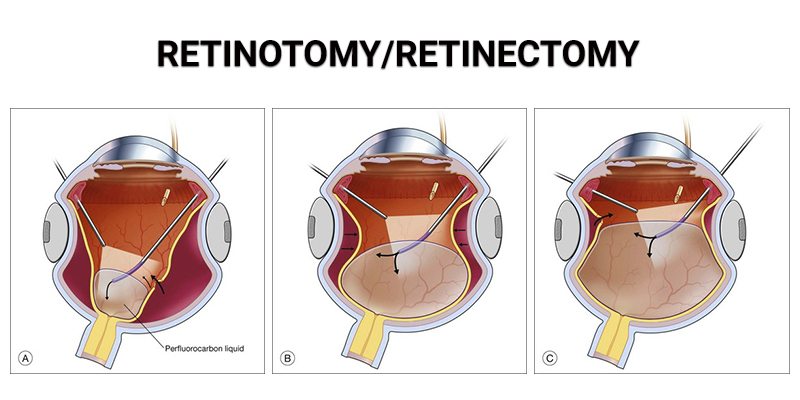 (212) 861-9797
(212) 861-9797
 (212) 861-9797
(212) 861-9797
Eye surgeries are complex enough, but the retinotomy procedure and the retinectomy surgery are more advanced than normal. While they’re often not your eye surgeon’s first recommendation for treatment, they’re done to protect your vision when necessary. And the best ophthalmologists to perform these procedures operate out of Vitreous Retina Macula Consultants of New York, retinal centers. With locations in Manhattan, Brooklyn and Westchester, these eye doctors use state-of-the-art equipment and the latest techniques to save your vision. Call the practice today to schedule a consultation if you notice vision problems.
A retinotomy involves cutting into your retina. The extent of the cut depends on the eye procedure. A top ophthalmologist may cut a hole to allow subretinal fluid to drain or to gain access to the subretinal space. A retinectomy, on the other hand, involves removing the subretinal membrane as part of a treatment for retinal traction, a condition that threatens your vision. Both procedures improve your vision by correcting retinal disorders.

A retinotomy is the more common surgery, as it’s a complementary procedure during a retina detachment repair. The surgery may also be coupled with vitrectomy techniques. A retinotomy can also remove substances from under your retina or improve the outcome of subretinal surgery.
If you have a diagnosis of a retinal detachment or another retina disorder, a top retina specialist at Vitreous Retina Macula Consultants of New York (VRMNY) may recommend a retinotomy, a retinectomy or another procedure. The internationally renowned retina specialists and ophthalmologists perform the most intricate eye surgical procedures, including laser surgeries, to treat a range of eye conditions successfully.
Dr Sorenson and personnel at vrmny are very professional and caring. I could not be more satisfied with their attentiveness.i have patronized vrmny for four years and have not been disappointed at any time. Even through the COVID emergency the doctors and staff maintained their professionalism. I am presently recovering from surgery performed by Dr Sorenson and have absolute confidence of full and satisfactory restoration of my sight.thank you Dr Sorenson
ERNESTO Z. GoogleA retinectomy involves the excision of your peripheral retina without touching the central part of your retina. In this eye procedure, your eye doctor either removes the entire nonessential or functionless peripheral retinal tissue or just the fixed edge of the retinal flap. Situations where a retinectomy procedure improves your vision include:
A retinotomy and a retinectomy are complex eye procedures that only the most qualified eye specialists perform. The eye doctors at VRMNY do extensive research to discover safer and more efficient eye treatments. These experienced doctors are at the forefront in innovation.
Retinal detachment is an eye emergency. It refers to a condition in which your retina is pulled away from its normal position. When this happens, it detaches from the blood vessels that supply it with nutrients. If it’s not resolved in a timely manner, a detached retina can lead to permanent vision problems. A retinotomy and retinectomy are among the more advanced procedures used to repair a detached retina and correct the associated complications. You’re a good candidate for a retinotomy or a retinectomy if:
The decision to perform a retinotomy or retinectomy depends on your diagnosis. These are complex procedures, and your eye doctor performs them only after determining other retinal surgeries can’t work. Your eye doctor at VRMNY discusses these procedures with you so you understand what it does and what’s at stake.
Years ago, eye doctors used a posterior drainage retinotomy, but the risk of complications has made the peripheral drainage retinotomy more reliable. If your eye doctor finds no pre-existing retinal tear or the tear is inadequate for drainage, a drainage retinotomy becomes the best solution. Your ophthalmologist decides on a retinotomy or retinectomy procedure after a clear diagnosis. In the right situation, one of these procedures alleviates the complications of retinal detachment surgery. The main steps involved include:
A retinectomy and retinotomy are extreme procedures required for complex eye problems. With a diagnosis for complex retinal detachment, your eye doctor at VRMNY performs these procedures to improve or even save your vision. Contact the best eye specialists today to enjoy revolutionary eye treatments at the leading eye practice in NYC.
Let us help you enjoy your life
Call: (212) 861-9797To Speak With An Appointment Coordinator Now